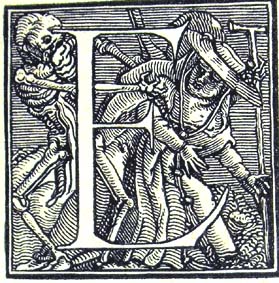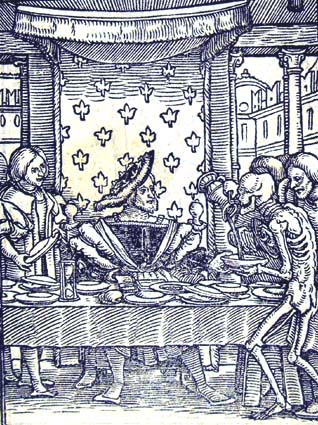Hans Holbein's Dance of Death
|

Hollar's engraved portrait
of
Holbein (Gemmell 15) |
The most famous, and original, incarnation of the Dance of
Death in book illustration is found in Hans Holbein's Les
Simulachres & historiees faces de la Mort. Hans Holbein the Younger
(1497-1543) was a German
artist and printmaker. He spent much of
his career working on themes of religious suffering, but is also
well-known for his painting The Ambassadors, in which an
image of a skull is hidden in anamorphic
perspective offering an almost subliminal memento mori message.
Holbein also spent part of his career in England and was portrait
painter for Henry VIII. Yet his most famous work, and the one
which made his name, remains the Dance of Death.
Holbein's work is therefore the
starting point for our exploration of the illustrated Dance.
|
| The origins of Holbein's Dance of Death illustrations remain
something of a mystery. Holbein produced the designs whilst
working and living in Basel, a Swiss town with two important Dance
of Death murals. They were originally completed 12 years prior to
their first publication in 1538. An alphabet with decorative
initials incorporating preliminary studies for his Dance of Death
were also completed in 1524. These works were non-commissioned -
perhaps the reason that Holbein felt free to indulge in satire and
commentary, according to Collins.
The woodblocks created from Holbein's designs are now commonly
attributed to Hans Lutzelberger (1495?-1526), a skilled woodcutter
who brought Holbein's work to life. Lutzelberger's death in 1526
possibly left the original Dance of Death series incomplete. It
was not until his heirs later sold the finished blocks to
creditors that they ended up at the Treschel printing firm in
Lyons and were first published as Les Simulachres &
historiees faces de la Mort, autant elegamment pourtraictes, que
artificiellement imaginées. Holbein is not credited in
the work at all. |

Blown up from small
letterhead;
Loedel's
engravings reproducing Holbein's original
Dance of Death alphabet (Gemmell 40) |
|

Holbein's depiction of Adam and the creation of
Eve in the Garden of Eden (Gemmell 1)
|
The
original work consisted of 41 small woodcuts (65x50 mm in size). The sequence begins with religious
scenes of Adam and Eve being cast from the Garden of Eden and the
arrival of Death. From here, a series of
scenes follow in which various victims meet Death.
The images were incredibly popular, and further editions
quickly followed. These featured
additional blocks, believed to be half-finished. The work was also
soon translated into Italian and Latin from the original French.
The Special Collections copy (Gemmell 1) is a later edition from
1549; although published in Lyon, it features the Italian
translation of the text. It has additional blocks, bringing the total number of
images up to 53.
Holbein's designs mark a departure from the original conception
of the Dance. He presents individual scenes of each victim rather
than the rational round dance of death and the dying. Holbein's
great skill is evident in his ability to inject interest and
variety into the scenes. There is great creativity in the
depiction of different landscapes and interiors, avoiding
monotonous repetition. His Dance of Death is rightfully hailed as
a monumental achievement. |
| Each scene bears the same basic elements: Death
enters surprising his victim and we clearly see the reaction of the
victim. In every scene, the motif of the hourglass is present
to signal the approaching end. |
|

Detail
showing
Death's hourglass
|
Holbein retains the formula of
presenting victims from a multitude of social positions - from
those at the top of the social scale, such as the king (to the
right), down to those low of status. Frequently his images
pass judgement on those at the higher end of the patriarchy
who choose to abuse the power their status accords them; he
even goes so far as to portray real life figures. According to
Gundersheimer, for example, the king shown here is
"clearly a portrait of Francis I", King of France (1515-1547)
- France's first Renaissance monarch. The fleur-de-lys motif
behind the table represents the French monarchy and the barett the
king wears points to Francis I. The King enjoys food, drink and a
life of excess as Death approaches the table in the guise of a
plate bearer, ready to pluck the king from his comfortable life.
|
|

Illustration of the King and
Death (Gemmell 1) |
|

Illustration of the Monk or
Mendicant Friar (Gemmell 1) |
In the illustration of the mendicant monk shown here, Holbein levies his critical
judgement at a member of the clergy. The monk
receives a particularly vicious reception, with Holbein presenting
him as a mercenary individual who desperately attempts to
shield his alms box as Death surprises him. This is a
terrifying death, where an aggressive and taunting
Death physically claims his victim, dragging him to his end. The
flowing garments combined with the curling smoke creates a sense
of panicked movement emphasised by the look of horror on the
monk's face. The curlicue in the background represents a distinctive
trademark of Holbein's and is part of his
unique skill.
The characterisation of Death is particularly fascinating.
Although not anatomically correct (although, as Barnes points out, few
of Holbein's contemporary reader's would have been aware of this), what he
lacks in precision he makes up for in animation. As Barnes
observes, Holbein does not "draw death as a generalised
force." Instead he is a diverse character who expresses many
emotions throughout the series. He is in turn mocking, aggressive,
determined, resigned, and exhibits real human emotion. |
| Overall,
Holbein's Dance of Death may be interpreted as part of the
contemporaneous rise of Protestantism with its implicit
judgement against indulgence and excess. In comparison to
the heads of state and dignitaries, here we witness the
opposite end of the social scale. The poorly dressed, hunched old woman
is presented without any of the rich architecture or lavish
clothing present in the other scenes. Unlike the
scorn he shows for the monk, here Death displays a very different
attitude.
Some critics have suggested that Death's arm is raised aloft to
strike the old woman, but others see it as part of the dance,
mirroring his raised leg and the headdress he wears. In fact,
there is almost a strange air of compassion for the old woman
as Death takes her arm and gazes down on her without any of
the aggression seen above.
Interestingly, this is also one of the few
designs in Holbein's series that displays two figures of death - one who
leads the old woman and the other who hurries ahead, striking
up the dance. With their nimble gestures, and the presence of
musical accompaniment, this scene is more faithful to the
original Dance of Death concept where dancing skeleton's lead
slow, clumsy mortals. |

Illustration of the Old
Woman and, in
this instance, two figures of Death (Gemmell 1) |
|
Go to next section: Imitations of Holbein
|